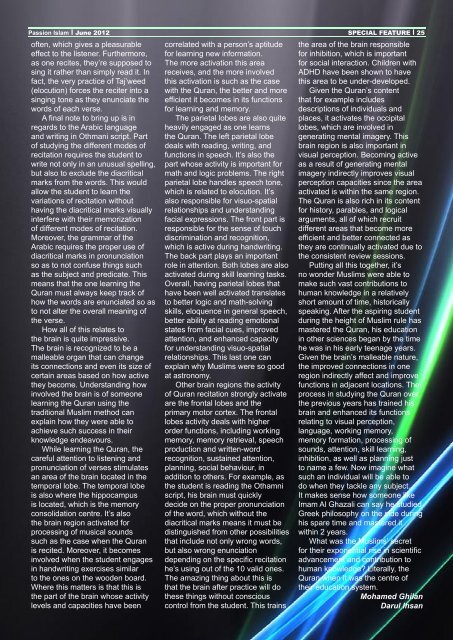You also want an ePaper? Increase the reach of your titles
YUMPU automatically turns print PDFs into web optimized ePapers that Google loves.
<strong>Passion</strong> <strong>Islam</strong> I June 2012 SPECIAL FEATURE I 25<br />
often, which gives a pleasurable<br />
effect to the listener. Furthermore,<br />
as one recites, they’re supposed to<br />
sing it rather than simply read it. In<br />
fact, the very practice of Taj’weed<br />
(elocution) forces the reciter into a<br />
singing tone as they enunciate the<br />
words of each verse.<br />
A final note to bring up is in<br />
regards to the Arabic language<br />
and writing in Othmani script. Part<br />
of studying the different modes of<br />
recitation requires the student to<br />
write not only in an unusual spelling,<br />
but also to exclude the diacritical<br />
marks from the words. This would<br />
allow the student to learn the<br />
variations of recitation without<br />
having the diacritical marks visually<br />
interfere with their memorization<br />
of different modes of recitation.<br />
Moreover, the grammar of the<br />
Arabic requires the proper use of<br />
diacritical marks in pronunciation<br />
so as to not confuse things such<br />
as the subject and predicate. This<br />
means that the one learning the<br />
Quran must always keep track of<br />
how the words are enunciated so as<br />
to not alter the overall meaning of<br />
the verse.<br />
How all of this relates to<br />
the brain is quite impressive.<br />
The brain is recognized to be a<br />
malleable organ that can change<br />
its connections and even its size of<br />
certain areas based on how active<br />
they become. Understanding how<br />
involved the brain is of someone<br />
learning the Quran using the<br />
traditional Muslim method can<br />
explain how they were able to<br />
achieve such success in their<br />
knowledge endeavours.<br />
While learning the Quran, the<br />
careful attention to listening and<br />
pronunciation of verses stimulates<br />
an area of the brain located in the<br />
temporal lobe. The temporal lobe<br />
is also where the hippocampus<br />
is located, which is the memory<br />
consolidation centre. It’s also<br />
the brain region activated for<br />
processing of musical sounds<br />
such as the case when the Quran<br />
is recited. Moreover, it becomes<br />
involved when the student engages<br />
in handwriting exercises similar<br />
to the ones on the wooden board.<br />
Where this matters is that this is<br />
the part of the brain whose activity<br />
levels and capacities have been<br />
correlated with a person’s aptitude<br />
for learning new information.<br />
The more activation this area<br />
receives, and the more involved<br />
this activation is such as the case<br />
with the Quran, the better and more<br />
efficient it becomes in its functions<br />
for learning and memory.<br />
The parietal lobes are also quite<br />
heavily engaged as one learns<br />
the Quran. The left parietal lobe<br />
deals with reading, writing, and<br />
functions in speech. It’s also the<br />
part whose activity is important for<br />
math and logic problems. The right<br />
parietal lobe handles speech tone,<br />
which is related to elocution. It’s<br />
also responsible for visuo-spatial<br />
relationships and understanding<br />
facial expressions. The front part is<br />
responsible for the sense of touch<br />
discrimination and recognition,<br />
which is active during handwriting.<br />
The back part plays an important<br />
role in attention. Both lobes are also<br />
activated during skill learning tasks.<br />
Overall, having parietal lobes that<br />
have been well activated translates<br />
to better logic and math-solving<br />
skills, eloquence in general speech,<br />
better ability at reading emotional<br />
states from facial cues, improved<br />
attention, and enhanced capacity<br />
for understanding visuo-spatial<br />
relationships. This last one can<br />
explain why Muslims were so good<br />
at astronomy.<br />
Other brain regions the activity<br />
of Quran recitation strongly activate<br />
are the frontal lobes and the<br />
primary motor cortex. The frontal<br />
lobes activity deals with higher<br />
order functions, including working<br />
memory, memory retrieval, speech<br />
production and written-word<br />
recognition, sustained attention,<br />
planning, social behaviour, in<br />
addition to others. For example, as<br />
the student is reading the Othamni<br />
script, his brain must quickly<br />
decide on the proper pronunciation<br />
of the word, which without the<br />
diacritical marks means it must be<br />
distinguished from other possibilities<br />
that include not only wrong words,<br />
but also wrong enunciation<br />
depending on the specific recitation<br />
he’s using out of the 10 valid ones.<br />
The amazing thing about this is<br />
that the brain after practice will do<br />
these things without conscious<br />
control from the student. This trains<br />
the area of the brain responsible<br />
for inhibition, which is important<br />
for social interaction. Children with<br />
ADHD have been shown to have<br />
this area to be under-developed.<br />
Given the Quran’s content<br />
that for example includes<br />
descriptions of individuals and<br />
places, it activates the occipital<br />
lobes, which are involved in<br />
generating mental imagery. This<br />
brain region is also important in<br />
visual perception. Becoming active<br />
as a result of generating mental<br />
imagery indirectly improves visual<br />
perception capacities since the area<br />
activated is within the same region.<br />
The Quran is also rich in its content<br />
for history, parables, and logical<br />
arguments, all of which recruit<br />
different areas that become more<br />
efficient and better connected as<br />
they are continually activated due to<br />
the consistent review sessions.<br />
Putting all this together, it’s<br />
no wonder Muslims were able to<br />
make such vast contributions to<br />
human knowledge in a relatively<br />
short amount of time, historically<br />
speaking. After the aspiring student<br />
during the height of Muslim rule has<br />
mastered the Quran, his education<br />
in other sciences began by the time<br />
he was in his early teenage years.<br />
Given the brain’s malleable nature,<br />
the improved connections in one<br />
region indirectly affect and improve<br />
functions in adjacent locations. The<br />
process in studying the Quran over<br />
the previous years has trained his<br />
brain and enhanced its functions<br />
relating to visual perception,<br />
language, working memory,<br />
memory formation, processing of<br />
sounds, attention, skill learning,<br />
inhibition, as well as planning just<br />
to name a few. Now imagine what<br />
such an individual will be able to<br />
do when they tackle any subject.<br />
It makes sense how someone like<br />
Imam Al Ghazali can say he studied<br />
Greek philosophy on the side during<br />
his spare time and mastered it<br />
within 2 years.<br />
What was the Muslims’ secret<br />
for their exponential rise in scientific<br />
advancement and contribution to<br />
human knowledge? Literally, the<br />
Quran when it was the centre of<br />
their education system.<br />
Mohamed Ghilan<br />
Darul Ihsan














